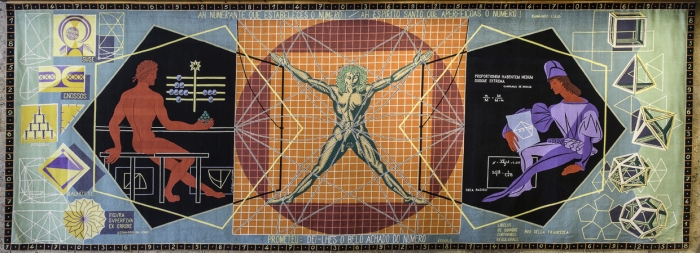RIHA Journal
About the Journal
Journal of the International Association of Research Institutes in the History of Art

The RIHA Journal was launched in 2010 by The International Association of Research Institutes in the History of Art (RIHA). It is a peer-reviewed and open access e-journal devoted to the full range of the history of art and visual culture. The RIHA Journal especially welcomes papers on topics relevant from a supra-local perspective, articles that explore artistic interconnections or cultural exchanges, or engage with important theoretical questions that are apt to animate the discipline. As a collective endeavor, the RIHA Journal seeks to share knowledge and materials issued by scholars of all nationalities, and by doing so, to make a significant contribution to dissolving the boundaries between scholarly communities. Languages of publication are English, French, German, Italian, or Spanish.
Just published:
RIHA Journal 0318
Eva Lieve Janssens on "'Oh, what sights to behold in this church turned upside down': Paulus de Kempenaer's Reckoning with the Roman Catholic Excesses"
DOI: https://doi.org/10.11588/riha.2024.1.103891

Robert Baudous after an anonymous designer, De Rhoemse Kercke, 1605, engraving, 415 × 1445 mm. Museum Boijmans Van Beuningen, Rotterdam, inv. no. BdH 24786 (PK) (photo: Studio Tromp, Rotterdam)
Recently published:
RIHA Journal 0316
Simão Palmeirim on "Almada Negreiros and Le Corbusier. Parallel Methodologies and Critical Reception"
DOI: https://doi.org/10.11588/riha.2024.1.105754

José de Almada Negreiros, Número, 1956, tapestry manufactured at Tapeçarias de Portalegre, wool, 254 × 702 cm. Tribunal de Contas, Lisbon, inv. 5394 (photograph provided by José Vicente / Câmara Municipal de Lisboa)

It is with great sadness that we have learned of the death of our esteemed colleague and friend, Santiago Alcolea, one of the founding members of RIHA, on August 10, 2024.
Santiago Alcolea Blanch, director of the Institut Amatller d’Art Hispànic, in Barcelona, for forty years, passed away on August 10, 2024. Born in Barcelona in 1951, the son of art historians Santiago Alcolea Gil and Montserrat Blanch, he was an undisputed national and international reference in artistic knowledge.
Graduated in art history from the University of Barcelona in 1975, Alcolea received technical training in an art restoration workshop between 1970 and 1972. His collaboration with his professor Josep Gudiol Ricart at the Institut Amatller began in 1974 and, from then on, he assisted him with several publications. In 1977, he became secretary of the institute based at the Casa Amatller in Passeig de Gracià, of which he was appointed director in 1984. Between 2009 and 2014, he focused his attention on the restoration of the building by Josep Puig i Cadafalch. His aim was to restore the house of chocolate maker Antoni Amatller to its 1900 appearance, when the architect transformed it into one of the first manifestations of modernism in Barcelona. For the reopening of Casa Amatller in 2015, he personally prepared the museum’s discourse and wrote the texts for the permanent exhibition and accompanying audiovisual materials.
In 1991, Alcolea joined the international group of art history research center directors that prepared the foundation of the International Association of Research Institutes in the History of Art (RIHA), which was established in Paris in 1998 and currently comprises some thirty of the most prestigious European and North American institutions in the field. He held the positions of secretary (1998-2000 and 2001-2003) and treasurer (2004-2006 and 2007-2009), and represented the Institute Amatller at the association’s annual general assemblies.
The first book Alcolea published was the result of his thesis, Subirachs a Catalunya: escultures públiques (Barcelona, Galeria Sacharoff, 1978). Soon after, he diversified his interests and published a study on Catalan academic flower painters of the 18th and 19th centuries, in Estudis d’art I cultural (Barcelona, Daedalus, 1979). Among his most innovative contributions is the essay entitled Aníbal, máscaras y anamorfosis en el 'Cuaderno italiano' de Goya (Barcelona, Institut Amatller d'Art Hispànic, 1998). He is also notorious for his work, Pintura gòtica catalana (Barcelona, Polígrafa, 1987), written in collaboration with Josep Gudiol, a complete documentary compilation of all known Catalan Gothic painting, with a catalog of each work, and for his historical monograph on the Prado Museum (Barcelona, Polígrafa, 1991 and 1992; Barcelona, Círculo de Lectores, 1994; Barcelona, Polígrafa, 2002).
Alcolea was particularly prolific in the field of exhibitions. He signed the general project of La pintura gótica en la corona de Aragón (Saragossa, Museu i Institut Camón Aznar, 1980) and successfully promoted an exhibition to commemorate the six hundredth anniversary of the death of Pere III, el Ceremoniós (Barcelona, Fundació Jaume I, 1987). He collaborated on numerous major exhibitions throughout Spain, but his most constant dedication remained to the multiple ones that he directed based on the Casa Amatller collection, such as Le Grand tour. El viatge d'Antoni Amatller al Marroc l'any 1903 (Barcelona, Fundació Amatller, 2005), Le Grand tour II. Constantinople 1905. Fotografies d'Antoni Amatller a Turquia (Barcelona, Fundació Amatller, 2006), La missió arqueològica del 1907 als Pirineus (Barcelona, Fundació Institut Amatller d'Art Hispànic i Fundació La Caixa, 2008) and Ànimes de vidre. Les colleccions Amatller (Barcelona, Museu d'Arqueologia de Catalunya, 2010).
He also contributed to a number of specialized magazines, including Boletín del Museo e Instituto Camón Aznar (Saragossa), Goya (Madrid), Revista Vic (Vic), Studia Vicensia (Vic) and Archivo Español de Arte (Madrid), in which he published a detailed work on the painter Marià Fortuny (1990), of whom he was one of the most consulted specialists.
Today, in sorrow, the entire RIHA community honors the memory of one of its founding members, notable collaborator and dedicated friend.



